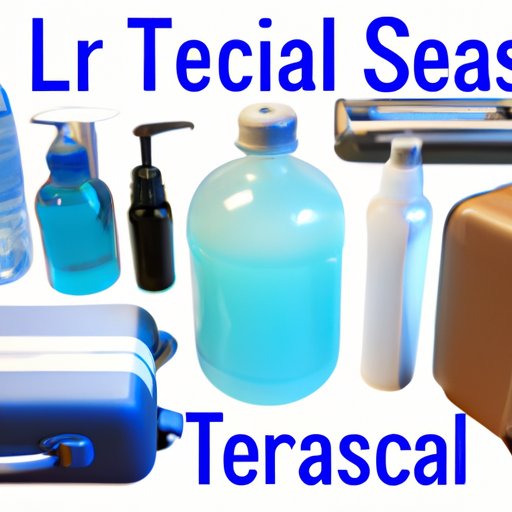
Introduction
Traveling can be exciting, but it can also be challenging, especially when it comes to carrying liquids on flights. Whether you’re flying for business, pleasure, or both, bringing along your favorite toiletries and snacks in your carry-on can make your travel experience more comfortable. However, with the Transportation Security Administration (TSA) regulations, you need to stay informed about the current rules and limitations on liquids you can carry. This article will provide you with practical information on how many oz can you fly with, so you can navigate TSA regulations with confidence.
Traveling Light: Understanding the Rules and Limitations of Carrying Liquids on Flights
The TSA’s 3-1-1 rule is the fundamental rule in carrying liquids on flights. It allows passengers to bring a quart-sized bag of liquids, aerosols, gels, creams, and pastes that are no more than 3.4 oz (100 ml) per item in carry-on bags. This rule is designed to simplify the security screening process for travelers while still maintaining safety measures. Passengers should place their quart-sized bag in their carry-on luggage and take it out for screening at the TSA checkpoint. Remember that only one quart-sized bag is allowed per passenger.
It’s essential to remember that packing allowed liquids appropriately is crucial to avoid having them confiscated during screening. Travel-sized toiletries, such as toothpaste, shampoo, and conditioner, should be in bottles no larger than 3.4 oz. Alternatively, if you’re only bringing a large container of a toiletry, you can transfer it to a smaller container and label it appropriately using masking tape. You can also use solid or dry versions of your preferred toiletries like toothpaste tablets or shampoo bars.
Savvy Packing: Tips for Packing Efficiently and Maximizing Your TSA-Approved Liquids Allowance
If you’re wondering how many oz can you fly with, you can minimize the amount of approved liquids by packing smartly. Before packing, consider what you need during your flight. Aim to bring only the necessary amount of toiletries and snacks to save space in your quart-sized bag. Choose multi-purpose items, such as a lip balm with SPF, to reduce the number of necessary products in your carry-on. You can buy snacks and drinks after you get through security to avoid using up valuable liquid space in your quart-sized bag.
Another way to maximize your TSA-approved liquids allowance is to invest in space-efficient and leak-proof containers. You can find various sizes of approved containers that are designed for travel. Consider using squeeze bottles or vials for liquids. You may also use silicone travel bottles or jars that don’t crack or leak. To avoid losing the contents of your quart-sized bag, place all the containers in a high-quality ziplock bag.
Airline Carry-On Rules: Navigating the Restrictions on Liquid Amounts and Container Sizes
It’s crucial to remember that TSA liquid regulations aren’t the only rules you need to follow. Airlines also have their own rules for liquids carried on-board, and these vary depending on the airline. Airlines may allow travelers to bring onboard the same amounts of liquid as the TSA regulations, but others may enforce stricter limits or not allow liquids at all on board.
When traveling domestically, check the airline’s website for specifics on liquid allowances, as they differ from TSA’s 3-1-1 rule. Many airlines partner with TSA to implement the 3-1-1 rule; however, some have stricter guidelines. Always comply with the highest level of restrictions, whether it’s the airline’s specific rule or TSA’s 3-1-1 rule.
When traveling internationally, different countries will have varying liquid policies and guidelines. It’s essential to research these rules before you depart. Some countries may have more lenient policies for liquids, while others may have stricter restrictions. If you’re flying to multiple destinations, consider each country’s rules and regulations.
Checking vs. Carrying: Determining When It’s Better to Pack Liquids in Checked Baggage Versus Carry-On
If you’re traveling with a lot of liquids, you may consider packing them in your checked luggage. However, this can be risky since fluids can leak or break during transit. Also, if you need a particular product during your flight, you won’t have access to it. In contrast, carrying your approved liquids in your carry-on offers easier access while traveling, and you can keep an eye on them throughout the journey and avoid the possibility of loss or damage.
Assess your specific travel needs before deciding whether to pack liquids in your checked bags or carry-on. Consider the length of your trip and the duration of your flight. If you’re taking a short domestic flight, carrying your liquids in your carry-on may be the best option. But if you’re going on an international trip that lasts several days, you may consider packing your liquids in the suitcase to avoid carrying too much load in your carry-on.
Traveling Internationally? Knowing the Liquid Restrictions of Other Countries and Airlines
When traveling internationally, different countries and airlines have varying liquid policies and guidelines. Most countries have their restrictions based on the 3-1-1 rule. Some countries may have different restrictions, making it essential to know ahead of time.
If you’re traveling internationally, review the country’s restrictions on liquids before you pack them. In addition to rules about how much liquid you can carry, some countries have policies about what liquids are permissible. Researching these rules before you leave can save you hassle during your travels.
Conclusion
Traveling light with liquids may seem like a challenge, but it doesn’t have to be. Following these tips on how many oz can you fly with can make your travel experience less stressful. Understanding TSA regulations on liquids will help you pack efficiently, avoid unnecessary delays for security screening, and have a more comfortable journey. Remember that you can pack essential items as long as you prepare them according to the TSA 3-1-1 rule. Planning ahead and knowing the rules about airline-specific liquid restrictions and international regulations can save you time, money, and hassle.




